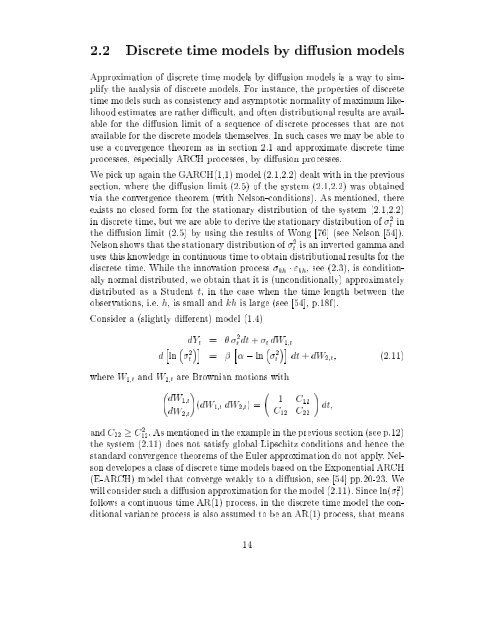Estimation in Financial Models - RiskLab
Estimation in Financial Models - RiskLab
Estimation in Financial Models - RiskLab
Create successful ePaper yourself
Turn your PDF publications into a flip-book with our unique Google optimized e-Paper software.
2.2 Discrete time models by diusion models<br />
Approximation of discrete time models by diusion models is a way to simplify<br />
the analysis of discrete models. For <strong>in</strong>stance, the properties of discrete<br />
time models such as consistency and asymptotic normality of maximum likelihood<br />
estimates are rather dicult, and often distributional results are available<br />
for the diusion limit of a sequence of discrete processes that are not<br />
available for the discrete models themselves. In such cases we may be able to<br />
use a convergence theorem as <strong>in</strong> section 2.1 and approximate discrete time<br />
processes, especially ARCH processes, by diusion processes.<br />
We pick up aga<strong>in</strong> the GARCH(1,1) model (2.1,2.2) dealt with <strong>in</strong> the previous<br />
section, where the diusion limit (2.5) of the system (2.1,2.2) was obta<strong>in</strong>ed<br />
via the convergence theorem (with Nelson-conditions). As mentioned, there<br />
exists no closed form for the stationary distribution of the system (2.1,2.2)<br />
<strong>in</strong> discrete time, but we are able to derive the stationary distribution of 2 t <strong>in</strong><br />
the diusion limit (2.5) by us<strong>in</strong>g the results of Wong [76] (see Nelson [54]).<br />
Nelson shows that the stationary distribution of 2 t is an <strong>in</strong>verted gamma and<br />
uses this knowledge <strong>in</strong> cont<strong>in</strong>uous time to obta<strong>in</strong> distributional results for the<br />
discrete time. While the <strong>in</strong>novation process kh " kh , see (2.3), is conditionally<br />
normal distributed, we obta<strong>in</strong> that it is (unconditionally) approximately<br />
distributed as a Student t, <strong>in</strong> the case when the time length between the<br />
observations, i.e. h, is small and kh is large (see [54], p.18f).<br />
Consider a (slightly dierent) model (1.4)<br />
d h ln 2 t<br />
dY t = 2 t dt + t dW 1;t<br />
i<br />
= h , ln 2 t<br />
i<br />
dt + dW2;t ; (2.11)<br />
where W 1;t and W 2;t are Brownian motions with<br />
!<br />
!<br />
dW 1;t<br />
1 C<br />
(dW 1;t dW 2;t )=<br />
12<br />
dt;<br />
dW 2;t C 12 C 22<br />
and C 22 C 2 12. As mentioned <strong>in</strong> the example <strong>in</strong> the previous section (see p.12)<br />
the system (2.11) does not satisfy global Lipschitz conditions and hence the<br />
standard convergence theorems of the Euler approximation do not apply. Nelson<br />
developes a class of discrete time models based on the Exponential ARCH<br />
(E-ARCH) model that converge weakly to a diusion, see [54] pp.20-23. We<br />
will consider such a diusion approximation for the model (2.11). S<strong>in</strong>ce ln( 2 t )<br />
follows a cont<strong>in</strong>uous time AR(1) process, <strong>in</strong> the discrete time model the conditional<br />
variance process is also assumed to be an AR(1) process, that means<br />
14
















